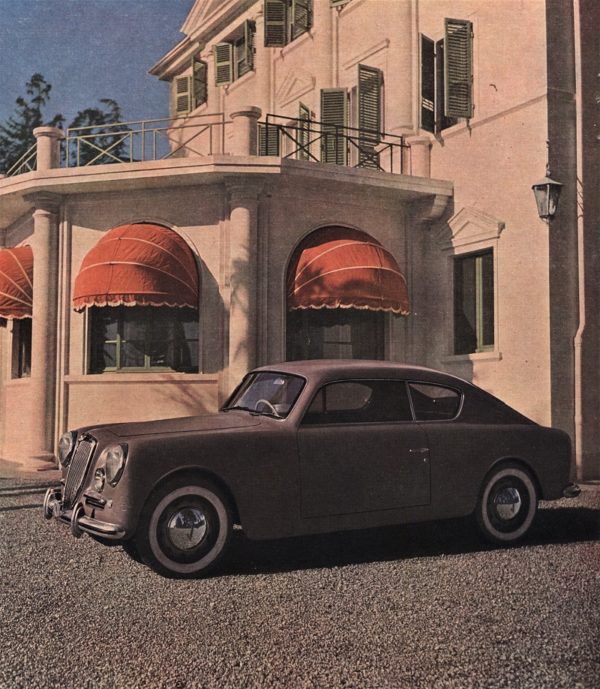
This beautiful picture was taken at the time of the car’s launch in 1951 at the Paris Salon. Not surprisingly, the caption included the words “one of the revelations of the 1951 season.”
There is something especially fresh and new about the car in this image, as might be expected for the first series. And, of a total of 3,871 coupés ever made, only 371 were produced in their first year.
The Lancia Aurelia saloon was launched one year earlier. It is notable for using the first ever series-production V6 engine. The saloon (designated B10) was joined in 1951 by the coupé (B20) and as late as 1955 by the spider and convertible (B24). Even as early as 1950 the car was offered in chassis form to be bodied by external coachbuilders.
Vittorio Jano was the engineer responsible for the car’s design, and its engine was a 60° design developed by Francesco de Virgilio, who worked as a Lancia engineer under Jano between 1943 and 1948. The engine was an all-alloy pushrod design with a single camshaft between the cylinder banks, a hemispherical combustion chamber and in-line valves.
Innovation was certainly not limited to the V6 engine. Transmission was by an advanced rear transaxle combining gearbox, clutch, differential, and inboard-mounted drum brakes. The front suspension was a sliding pillar design, traditional for Lancia.
The first engines had a displacement of 1.8 litres, but in 1951 this increased to 2 litres, a size shared between the saloon and the newly launched coupé. In 1953, the engine in saloon and coupé grew again to 2.5 litres.
Another charming aspect of our first-series car is its right-hand drive. It was not until the fourth series in 1954 that the cars were available in left-hand drive; this series was the first to be imported into the USA in any number, and at the same time replaced semi-trailing rear suspension with a De Dion tube.
More luxury came with the fifth series of 1956, and for 1957 the sixth series introduced quarter-lights to the coupé – but the simple, stylish look of the car hardly changed throughout its production.
The Aurelia coupé performed well in competition. In the 1951 Mille Miglia a 2-litre Aurelia B20 coupé, driven by Giovanni Bracco and Umberto Maglioli, finished second, beaten only by a Ferrari 340 America. In the same year, it took first in class and 12th overall at Le Mans. Aurelias took the first three places in the 1952 Targa Florio and a win in the 1953 Liège-Rome-Liège.
In popular culture, it was the more exotic B24 convertible that became one of the most iconic cars in Italian cinema in the 1962 film Il Sorpasso. But, not to be outdone, a B20 coupé was a star of The Calculus Affair, one of The Adventures of Tintin, in the story’s car chase scene. Models of this car are available and include the driver Arturo Benedetto Giovanni Guiseppe Pietro Archangelo Alfredo Cartoffoli da Milano, with Captain Haddock clinging to the bonnet. Cartoffoli allegedly had a great pride in Italian cars, which he claimed were the best in the world.
Picture courtesy of the Richard Roberts Archive







The saloon was available in left hand drive in 1951 to 1953 but it wasn’t until 1954 that the Coupe was built in this form.
The Saloon grew to 2.2 litres, the Coupe to 2.5.
There were various convertibles. The first B24 was the Spider, the later cars had a more conventional windscreen and were known as the Convertible.
Coachbuilders could buy a bare chassis and body it in their own choosing, and there were a number of bodies from lots of coachbuilders.